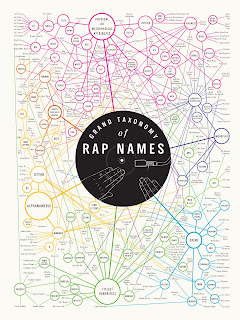

Here I have posted three different examples of design using lines. The chart of rapper names is strictly informational, the book page is imagery overlapping text to emphasize segments and meanings in the text, and the image of the spider with some other lines doesn't have a known meaning. The poster and book page both cam from ffffound.com. The other picture comes from a far different source and might be considered a little unorthodox.
The poster is pretty much a flow chart of rapper names. It reminds me of the mind maps we did in viscom. There are six sections that the names are divided into and these are shown with their own color of lines on the poster. These lines then criss cross and span the page to establish connections in rapper names between each of the categories. These lines create a really smooth gradation in the poster and make it more than just informational. Yet the poster doesn't ever lose its readability. I was able to properly find every member of the Wu Tang Clan (except Inpectah Deck) based on their names and the categories presented. It took a little searching but I was able to find eight of them without any real hassle.
I find the book page really interesting because it reminds me a lot of transparencies we used in our books for viscom and type. I don't know if the page shown is actually a transparency of images on top of a page of text or if maybe someone doodled in a book, or even if the book was printed this way. Any which way it is the page is very clever in my opinion by leaving the open "windows" for the text to show through.
The final image is easily the oldest. I still feel like it's a really good example of lines, design , and craft though even if it might not be a typical concept of graphic design. There are many of these compositions in the Nazca valleys in Peru. They were crafted by Native Americans as long ago as the 1920s. This was just when they were discovered though due to airplane travel. These structures are enormous and some span several miles. They couldn't have been seen from anywhere other than above so it's possible that they've existed longer. The purpose for these aren't known but I suspect they were used to communicate with the gods of whatever people crafted them. There size is what makes them so impressive. They literally span miles and when seen from above these lines seem perfectly straight. How could these people have hand crafted these massive mounds for miles AND keep them straight? Religious devotion.


No comments:
Post a Comment